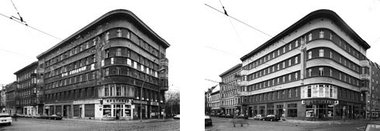John Hurrell – 3 November, 2009
With the progress of time they have become more youthful. Like a movie running backwards where dilapidation is repairing itself.
West German photographer Stefan Koppelkamm happened to be in East Germany in 1990 just after the collapse of the Berlin Wall (but prior to reunification), and so thinking that the architecture looked as it might have been before the Second World War, he began documenting it. After the reunification of Germany, he decided to revisit those same buildings eleven or twelve years later to see what changes had occurred, and to record them from exactly the same position as the original images.
As this exhibition testifies, the differences were profound. This show of ten pairs of b/w images, selected samples toured by the Goethe Institut, illustrates a transmutation from decrepit slums to what seem to be areas of gentrification. The initially crumbling facades of these buildings have not only been transformed but in some cases, the architectural structures have been knocked down and completely replaced.
In most examples it is an odd feeling looking at images where time seems to have gone into reverse, where decay is manifest in older versions but absent in recent ones. With the progress of time they have become more youthful. Like a movie running backwards where dilapidation is repairing itself.
With each pair you continually compare wall surfaces, window positions, spaces between structures, roof levels, street paving, curb edges, lamp-posts and models of car. Sometimes the buildings originally photographed were ruins abandoned for 45 years after the war. A few have even been left alone, ignored.
With this exhibition the Goethe Institut has published a nice little (pointedly) red-covered book of twenty-three sets of these historical photographs - with excellent commentaries by the artist and Ludger Derenthal, the Director of the Museum Für Fotografie for the Staatliche Museen Berlin. It’s an interesting show about the demise of the GDR, and superficially, the success of capitalism. At least in 2001-3. What the mood is like in these places now, six or seven years later, in the current economic climate is bound to be much more pessimistic.
Recent Comments
John Hurrell
Thanks Giovanni for your trouble.
Giovanni Tiso
Remaining New Zealand dates for this one: Wellington, Rutherford House / VUW, 5 Nov - 30 Nov 2009 Palmerston North, ...
Giovanni Tiso
How daft of me not to think of phoning the Goethe Institut... thanks.




 Two Rooms presents a program of residencies and projects
Two Rooms presents a program of residencies and projects Advertising in this column
Advertising in this column



This Discussion has 5 comments.
Comment
Giovanni Tiso, 4:05 p.m. 12 November, 2009 #
Do you know if the exibition will tour? I assume so but there's no indication on any of the linked pages - perhaps I'm missing something. Would very much like to see it.
John Hurrell, 4:05 p.m. 12 November, 2009 #
The top link (the show's title)suggests it is about to go to the Waikato Museum of Art and History Te Whare Taonga o Waikato. Give them a ring.07 838 6606.However it is not mentioned on their website.
You could contact the Goethe Institut in Wellington (04) 385 6924
Giovanni Tiso, 4:06 p.m. 12 November, 2009 #
How daft of me not to think of phoning the Goethe Institut... thanks.
Giovanni Tiso, 4:06 p.m. 12 November, 2009 #
Remaining New Zealand dates for this one:
Wellington, Rutherford House / VUW, 5 Nov - 30 Nov 2009
Palmerston North, Te Manawa Museum, 7 Nov - 15 Nov 2009
Dunedin, Otago Museum, 8 Nov - 10 Nov 2009
John Hurrell, 4:06 p.m. 12 November, 2009 #
Thanks Giovanni for your trouble.
Participate
Register to Participate.
Sign in
Sign in to an existing account.